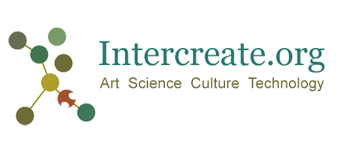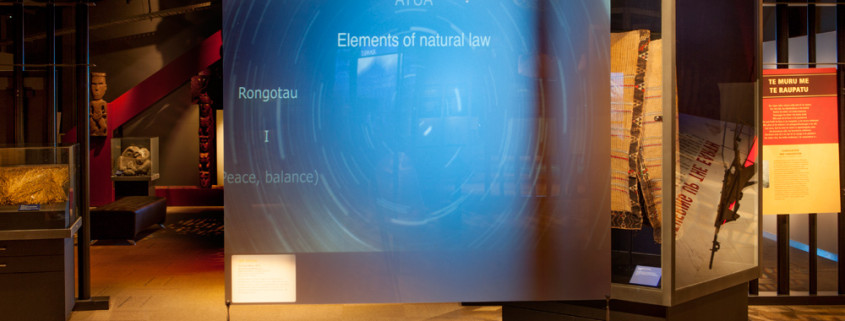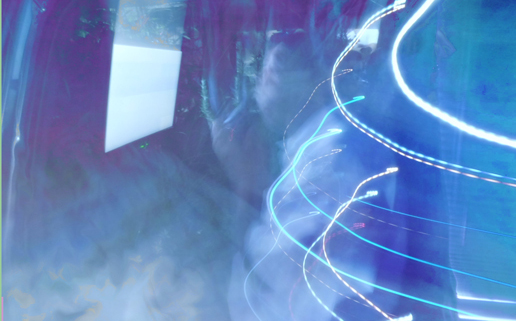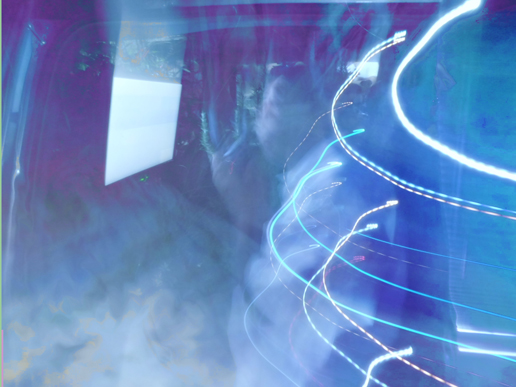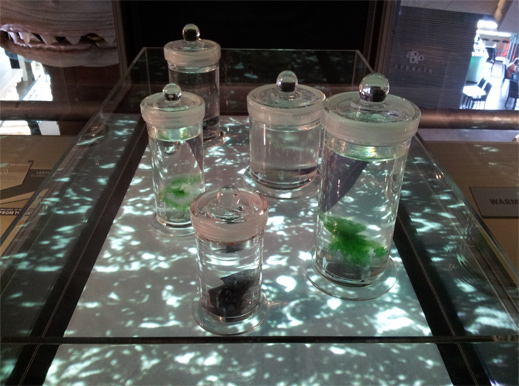
Iwasaki, Hideo cultures cyanobacteria which then photosynthesise according to the light of the moving image work projected from below (from the 3rd nature exhibition
Intercreate.org projects and exhibitions
This page has introductory information about Intercreate.org projects, which include our biennial project SCANZ, exhibitions in Albuquerque, Istanbul, Rio and in Aotearoa New Zealand.
Upcoming
We are currently working on exhibition projects for Sydney, Albuquerque and Taos and Nga Motu New Plymouth. SCANZ 2015 will be themed Wai (water) and Peace, two significant issues facing humanity.
SCANZ 2013: 3rd nature exhibition

‘The electromagnetic sensory world of sharks’ by Mike Paulin, a Zoologist was projected onto the mesh of a ‘sail’, in the galleries which houses traditonal Maori artefacts.
3rd nature at Puke Ariki integrated museum and library. To see works in the 3rd natureshow, click the image above.
Wai (for ISEA 2012 Albuquerque)

Te Urutahi Waikerepuru, Dine’/Navajo musician Andrew Thomas and his partner, Te Huirangi Waikerepuru, myself, Johnson Dennison, Gordon Bronitsky and Rosemary Dennison just before the ceremonies started.
Water is essential for life, sacred to many indigenous peoples worldwide and endemic to natural processes. This project connects Maori cosmology, notions of integrated systems, Western art and science in order to reinvigorate our understanding of flow and water. The project reiterates the urgent need to engage with sustainable practices given climate change. It also underlines the importance of listening to the indigenous voice on the environment.
The Wai (Maori for water or flow) project uses technology to connect distant spaces and cultures around the theme of water. Water holds significance for Maori of New Zealand Aotearoa, Navajo/Dine in New Mexico and neighboring regions, and is essential to survival. Isleta Pueblo, Navajo/Dine and Maori ceremonies will be performed as part of the dawn opening for the exhibition.
The project is led by Te Huirangi Waikerepuru and curated by Ian Clothier. It will open September 19th at 516 Arts in Albuquerque. A collective of people spanning four countries and many cultures – Aotearoa New Zealand, USA, Australia, India and representatives of indigenous peoples -are presenting an interconnected project. The collective is known as Te Hunga Wai Tapu (the people for whom water is sacred).
For more information about Wai, check Wai exhibition and Wai participants.
Te Kore Rongo Hungaora Uncontainable Second Nature

Te Kore Rongo Hungaora Uncontainable Second Nature was a project of ISEA 2011 Istanbul. A travelling version has since been formed, for exhibition in Rio de Janeiro.
The exhibition crosses cultural and discipline boundaries. The location of five themes from within European and Maori world views, provides a framework with which to construct a cultural bridge between Maori and European of New Zealand. Culture is usually presented separated and distinct; given the intercultural bridge, works from art and science are recontextualised as cultural texts symbolic of belief systems. Discipline is not fixed, but fluid in a transformational environment. In the exhibition, digital and post-digital exist in a state of hybridity.
Curated by Ian Clothier with an advisory panel of Nina Czegledy, Trudy Lane and Tengaruru Wineera, for ISEA 2011 Istanbul. Supported by:


Exhibited works
Please see here for a list of all the projects involved in the exhibition »
Exhibition Venues
Event: ISEA 2011 UNCONTAINABLE
Venue: Cumhuriyet Art Gallery, Istanbul, Turkey
Dates: September 14th – October 12th, 2011
Exhibition Page: Uncontainable: Second Nature
Related Event: Eco sapiens Round Table
Event: CulturaDigital.Br International Festival
Venue: Rio de Janeiro, Brazil
Dates: December 2nd–4th, 2011
Exhibition Page: Rongo Hungaora: Second Nature [Travelling]
inter / place

The works in the exhibition inter/place present an attempt to come to grips in some way with the notion of multiplicity and a sense of distributed identity. Rather than gather all the artworks up in one area and present them as a selection of works on one theme, the artists taking part in this exhibition have been free to create their own work and explore different exhibition locations for that work. Subsequently none of these works have been placed in the conventional sites for exhibitions in Puke Ariki museum. There is no claim to novelty in this approach but rather the determination that a view based on distributed and multiple identity has been hybridised to the Puke Ariki location.
Venue
Puke Ariki – three works in the museum section and one in the library.
Date: December 2 2010 – February 3 2011.
A link to the catalogue is provided below.
InterPlaceWebPdf
Like us on Facebook
Follow us on Twitter
